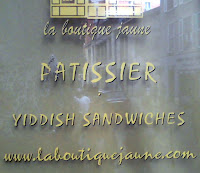The eighteenth arrondissement in Paris is quite a paradox. On the one hand, Arab restaurants offer free Ramadan food after sunset - it's late here, 9:10 last night - to those who can produce a valid social security card, hundreds of backsides pointing more or less away from the direction of Mecca ( yes, think about it...) line the pavements at prayer time because the mosques are too small and too full. The image isn't mine - my camera battery died, but this from near the Omar Mosque in 1991 captures the essence of the scene. These days, there's a high police profile and they clear the roads so the faithful are all squashed on to the pavements. Photographed by Jalai Abbas (Children of Abraham).
On the other hand , there are secret hideaways for the very very chic and at 240 euros a night, few of the faithful on the pavements will be able to afford to get through the door of le Kube Hotel, four stars. There's one here and one in St Tropez. It's unique in Paris since it's the only one with an ice bar - called - what else - le Ice Kube.
On arrival, you pay your 38 euros and are provided with arctic clothing. Inside, the bar and walls are made of ice and the temperature is -10 Celsius. Unless you're Canadian, in which case you might think it quite mellow, your stay is limited to half an hour. In that time, you get to taste four or five different vodkas. In my serious drinking days, I couldn't imagine myself here. Its frequented by rock stars, I am told, plus other well-known faces. Mine will not be photographed along with the frostbitten famous, I'm afraid, but I couldn't resist a few arty-farty shots.
The exterior. White blob on left is a polar bear. Quelle surprise...
The Ice Kube. From without.






























 I was directed up the hill to the arena, which was a space about sixty metres in diameter with an ominous barred lorry at one end and bars, seven feet high and two inches thick circumscribing the space. Young men, perhaps with something to prove to appraising female eyes in the crowd, stepped into the ring and waved their shirts as the bull was released. The aim of the game, it seemed was to bait the animal until you were chased by it, leaping nimbly over the barrier or climbing the scattered bales of hay out of reach of the eighteen inch horns. These were padded, but a number of the contestants retired 'hors de combat' with alarming bruises, keeping the Croix Rouge busy. If the beast, which could accelerate rapidly and corner astonishingly fast, actually caught someone they were tossed in the air like a rag doll. I was told that if anybody has to be hospitalised, they might stop the show. Thus, young men returned grimly to the arena, sporting antiseptic-coated welts and bruises. The bull had a disquieting habit of charging the barrier randomly, so, for the most part, I maintained a discreet presence behind it. The finale of the evening was a bull run. Camarguien cowboys armed with long, steel-tipped staves and riding their small white horses, wearing trademark leather hats and flowered shirts, corral a bull and drive it through the narrow streets, barricaded in the same way as the arena. Meanwhile, the local youth run in between the horses and the bull to try to wrestle it to the ground. A five hundred kilogram bull which is disinclined to be so treated can lose its temper very fast. The stench of fear, adrenalin, testosterone and, well, bullshit was quite unforgettable.
I was directed up the hill to the arena, which was a space about sixty metres in diameter with an ominous barred lorry at one end and bars, seven feet high and two inches thick circumscribing the space. Young men, perhaps with something to prove to appraising female eyes in the crowd, stepped into the ring and waved their shirts as the bull was released. The aim of the game, it seemed was to bait the animal until you were chased by it, leaping nimbly over the barrier or climbing the scattered bales of hay out of reach of the eighteen inch horns. These were padded, but a number of the contestants retired 'hors de combat' with alarming bruises, keeping the Croix Rouge busy. If the beast, which could accelerate rapidly and corner astonishingly fast, actually caught someone they were tossed in the air like a rag doll. I was told that if anybody has to be hospitalised, they might stop the show. Thus, young men returned grimly to the arena, sporting antiseptic-coated welts and bruises. The bull had a disquieting habit of charging the barrier randomly, so, for the most part, I maintained a discreet presence behind it. The finale of the evening was a bull run. Camarguien cowboys armed with long, steel-tipped staves and riding their small white horses, wearing trademark leather hats and flowered shirts, corral a bull and drive it through the narrow streets, barricaded in the same way as the arena. Meanwhile, the local youth run in between the horses and the bull to try to wrestle it to the ground. A five hundred kilogram bull which is disinclined to be so treated can lose its temper very fast. The stench of fear, adrenalin, testosterone and, well, bullshit was quite unforgettable.

















